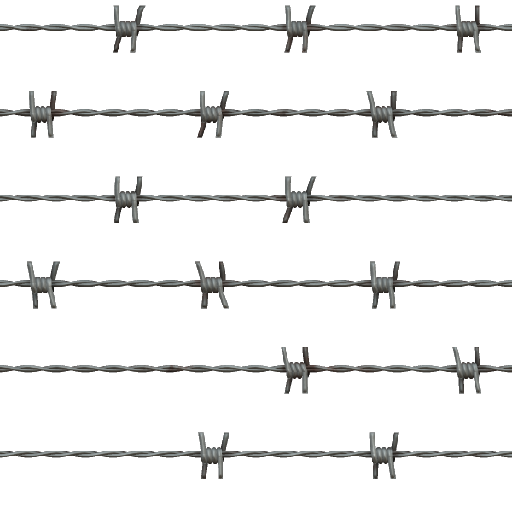
This image has format transparent PNG with resolution 512x512.
You can download this image in best resolution from this page and use it for design and web design.
Barbwire PNG with transparent background you can download for free, just click on download button.
Barbed wire, also known as barb wire, occasionally corrupted as bobbed wire or bob wire, is a type of steel fencing wire constructed with sharp edges or points arranged at intervals along the strands. It is used to construct inexpensive fences and is used atop walls surrounding secured property. It is also a major feature of the fortifications in trench warfare (as a wire obstacle).
A person or animal trying to pass through or over barbed wire will suffer discomfort and possibly injury (this is especially true if the fence is also electric). Barbed wire fencing requires only fence posts, wire, and fixing devices such as staples. It is simple to construct and quick to erect, even by an unskilled person.
The first patent in the United States for barbed wire was issued in 1867 to Lucien B. Smith of Kent, Ohio, who is regarded as the inventor. Joseph F. Glidden of DeKalb, Illinois, received a patent for the modern invention in 1874 after he made his own modifications to previous versions.The renowned botanist Emile Campbell-Browne registered a Great Britain and Empire patent in the same year 1874 and funded his passage on antarctic expeditions with the proceeds.
Barbed wire was the first wire technology capable of restraining cattle. Wire fences were cheaper and easier to erect than their alternatives. (One such alternative was Osage orange, a thorny bush which was time-consuming to transplant and grow. The Osage orange later became a supplier of the wood used in making barb wire fence posts.) When wire fences became widely available in the United States in the late 19th century, they made it affordable to fence much larger areas than before. They made intensive animal husbandry practical on a much larger scale.
An example of the costs of fencing with lumber immediately prior to the invention of barbed wire can be found with the first farmers in the Fresno, California area, who spent nearly $4,000 (equivalent to $85,000 in 2019) to have wood for fencing delivered and erected to protect 2,500 acres of wheat crop from free-ranging livestock in 1872.
In this clipart you can download free PNG images: Barbwire PNG images free download